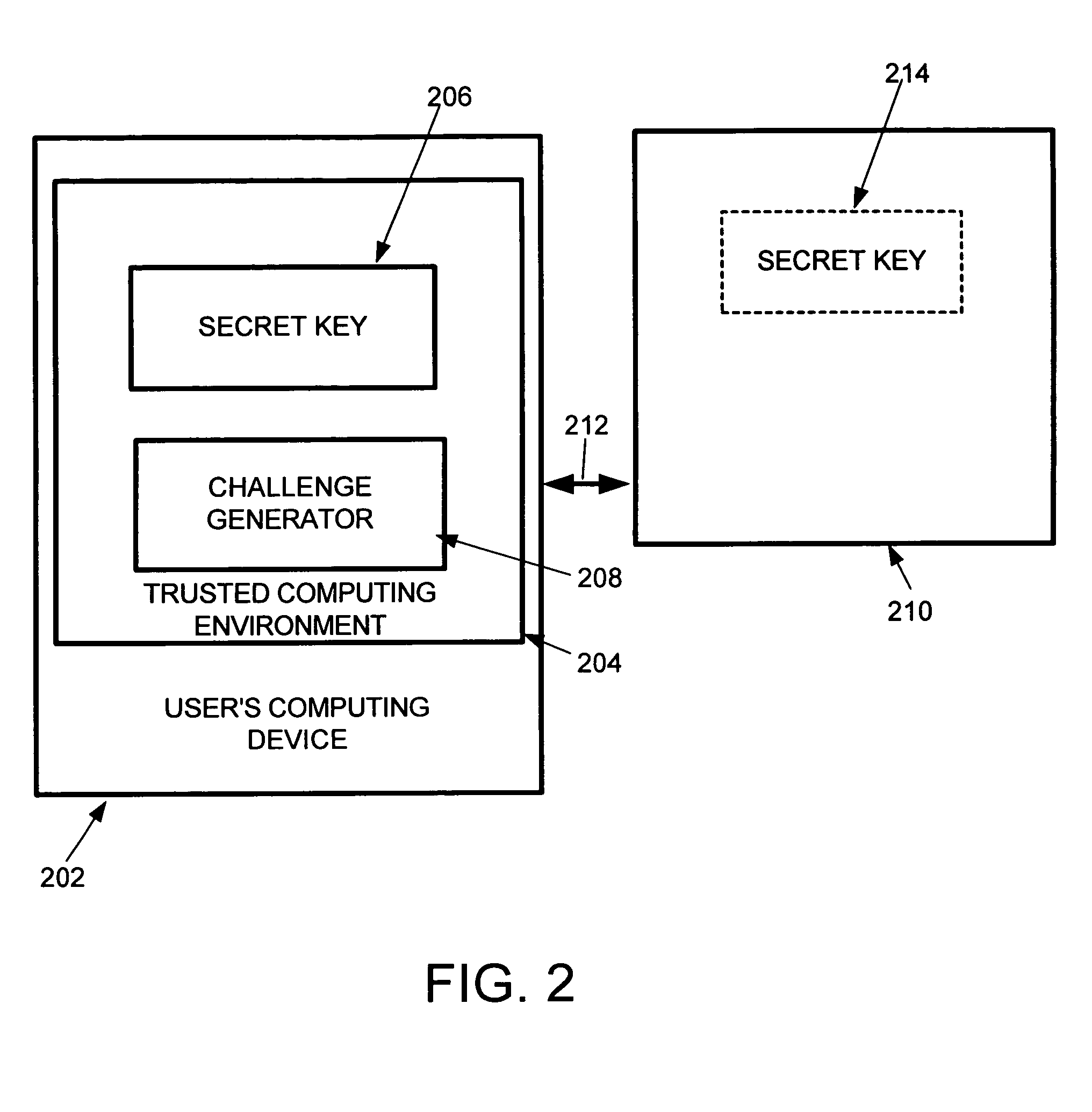[0008]The invention is directed toward a system and method for determining if a computer user is a human or a computer program such as an automated script. The system and method of the invention does not require a user to interact with a service provider in order to obtain and answer a challenge. Thus, the embodiments of the system and method according to the invention are advantageous in that they preclude the need for the great number of actions and time delays that are required for typical HIP systems where a service provider sends a challenge to a user, the user answers the challenge and sends their answer back to the service provider, and the service provider verifies the user's answer before allowing the user access to the service. Additionally, the invention allows some of the HIP costs to be shifted to devices owned by the user or a dedicated third party instead of the service provider.
[0009]In general, in one embodiment of the invention, a computer user's computing device is equipped with a trusted computing environment or device consisting of a challenge generator and a secret key. The challenge is generated for the user by the user's trusted computing environment or device, and the user answers the challenge. A digital signature which may or may not include the user's answer, or may be appended to the user's answer, is provided as part of the user's service request to a service provider to access their services. For example, the digital signature can be appended to the message body (which may include such things as the correct answer, timestamp, request for services, and so on) to prove the authenticity and integrity of the message to the service provider. Such a signed assertion or signed message created by the trusted computing environment or device, or trusted third party in the case where one is employed, proves to the services provider that the user has completed the challenge. This obviates the need for a separate challenge to be generated and sent from the service provider and the user's response to that challenge being sent back to the service provider. It also significantly reduces the burden on the service provider.
[0012]The foregoing embodiment of the invention can be exemplified in a version specific to electronic mail. In this version, the user's trusted computing environment computes a one-way cryptographic hash of the contents of a message using, for example, the date, the sender's name / address, the recipient's name / address, and the secret key. In general, a cryptographic hash is a mathematical function that maps values from a large (or even very large) domain into a smaller range, and is (a) one-way in that it is computationally infeasible to find any input which maps to any pre-specified output; and (b) collision-free in that it is computationally infeasible to find any two distinct inputs which map to the same output. In the present invention, the result of the aforementioned hash is used to generate a short sequence of alphanumeric characters which can, for example, then be rendered into a visual image that is given to the user as a challenge. The user can then identify the text string as their answer to the challenge and include it with the mail message. A recipient, such as the service provider, with access to the same secret key can check that the included text string matches the hash of the message contents, date, etc., and reject the message if there is no match. This relieves the sender from the burden of having to wait for a challenge from the recipient and relieves the recipient from having to send the challenges. Similar benefits can be obtained for other types of services besides email.
[0013]In yet another embodiment of the system and method according to the present invention, the user's trusted computing environment issues an arbitrary challenge to the user that requires the user to expend significant resources to answer. Upon successful completion of the challenge, the trusted computing environment or device digitally signs an assertion that the challenge has been successfully answered for a particular message. This embodiment of the invention operates on the theory that most automated scripts will not expend a great amount of computer resources in maliciously obtaining a service provider's services. In this embodiment the requirement for computation serves the same purpose as the challenge—raising the cost of the operation to deter abuse. The aforementioned signed assertion is attached to the user's message requesting the service provider's service in order to allow the recipient to verify that sufficient resources have been expended on this message.
[0014]A variant of the embodiment discussed in the paragraph above can be exemplified in an embodiment that employs the user's trusted computing environment to digitally sign an assertion for any message that it is given, but to report back to the user only a partial digital signature. The missing portion of the signature is then rendered as a challenge whose answer, when combined with the given portion of the signature, forms a complete signature. One advantage of this method is that it reduces the number of message round trips between the user and the trusted device from two (send message requesting services, receive challenge, answer challenge and receive signature) to one (send message requesting services and receive partial signature). In this variant, it is also possible for the user to perform a computational search for the missing portion of the signature—thus obviating the need for user interaction by expending computational resources rather than human effort on the message.
 Login to View More
Login to View More  Login to View More
Login to View More 


